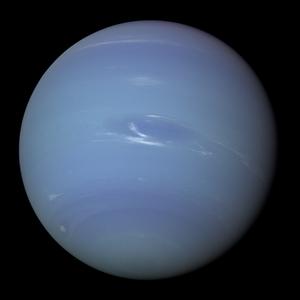Glossarbegriffe: Neptun
Description: Neptun ist der achte und am weitesten von der Sonne entfernte Planet. Wie sein Nachbar Uranus ist auch Neptun ein Eisriese. Sein Radius beträgt knapp 25 Tausend Kilometer (km), etwas weniger als das Vierfache des Erdradius. Neptun hat einen festen Gesteinskern, der von einer Schicht aus Wasser, Methan und Ammoniak, in der extrem hohe Drücke herrschen. Als das äußere Sonnensystem noch jung war, wurden diese chemischen Elemente gefroren und auf dem jungen Neptun abgelagert. Daher wird er als "Eisriese" bezeichnet. Die äußere Atmosphäre des Neptun besteht aus einer dicken, wolkigen Schicht aus Wasserstoff und Helium.
Seine typische Entfernung von der Sonne beträgt etwa 4,5 Milliarden km, also rund 30 Astronomische Einheiten (Abstand Erde-Sonne). Neptun hat mindestens 14 Monde und ein schwach ausgeprägtes Ringsystem. Als äußerster Planet spielt Neptuns Schwerkraft eine entscheidende Rolle bei der Gestaltung der Bahnen kleinerer Körper im Kuiper-Gürtel.
Neptun ist mit dem bloßen Auge nicht sichtbar. Er wurde erstmals aufgrund der Auswirkungen seiner Schwerkraft auf die Umlaufbahn des Uranus identifiziert. Die Mathematiker John Couch Adams und Urbain Le Verrier sagten Anfang der 1840er Jahre die Existenz und die Position des Neptun voraus. Auf der Grundlage von Le Verriers Berechnungen fand Johann Gottfried Galle Neptun im Jahr 1846. Neptun ist nach dem römischen Gott des Meeres benannt.
Zugehörige Glossarbegriffe:
See this term in other languages
Term and definition status: The original definition of this term in English have been approved by a research astronomer and a teacher The translation of this term and its definition is still awaiting approval
The OAE Multilingual Glossary is a project of the IAU Office of Astronomy for Education (OAE) in collaboration with the IAU Office of Astronomy Outreach (OAO). The terms and definitions were chosen, written and reviewed by a collective effort from the OAE, the OAE Centers and Nodes, the OAE National Astronomy Education Coordinators (NAECs) and other volunteers. You can find a full list of credits here. All glossary terms and their definitions are released under a Creative Commons CC BY-4.0 license and should be credited to "IAU OAE".
If you notice a factual or translation error in this glossary term or definition then please get in touch.
Zugehörige Medien
Neptune
Bildnachweis: NASA / JPL / Voyager-ISS / Justin Cowart credit link
License: PD Public Domain icons









